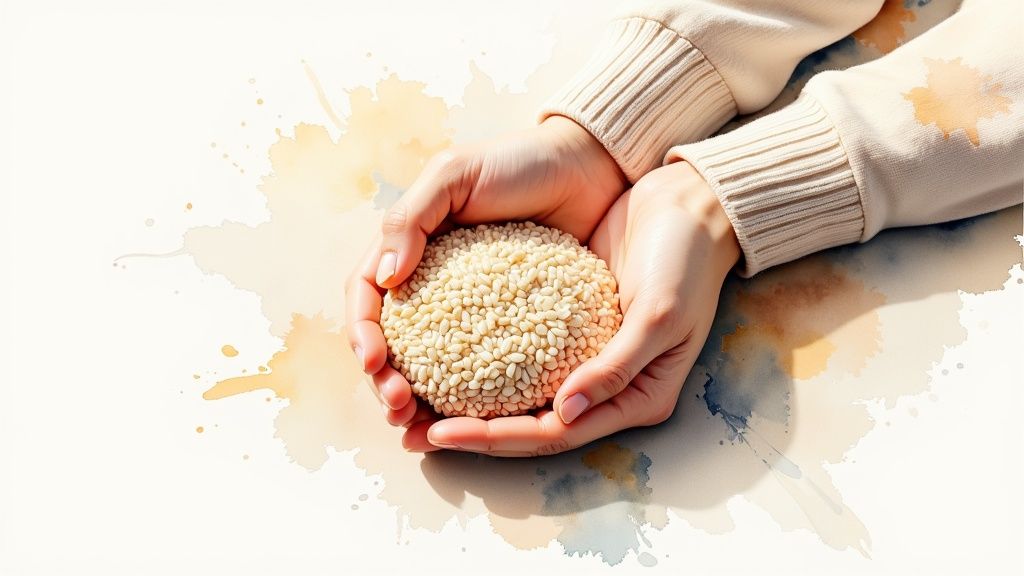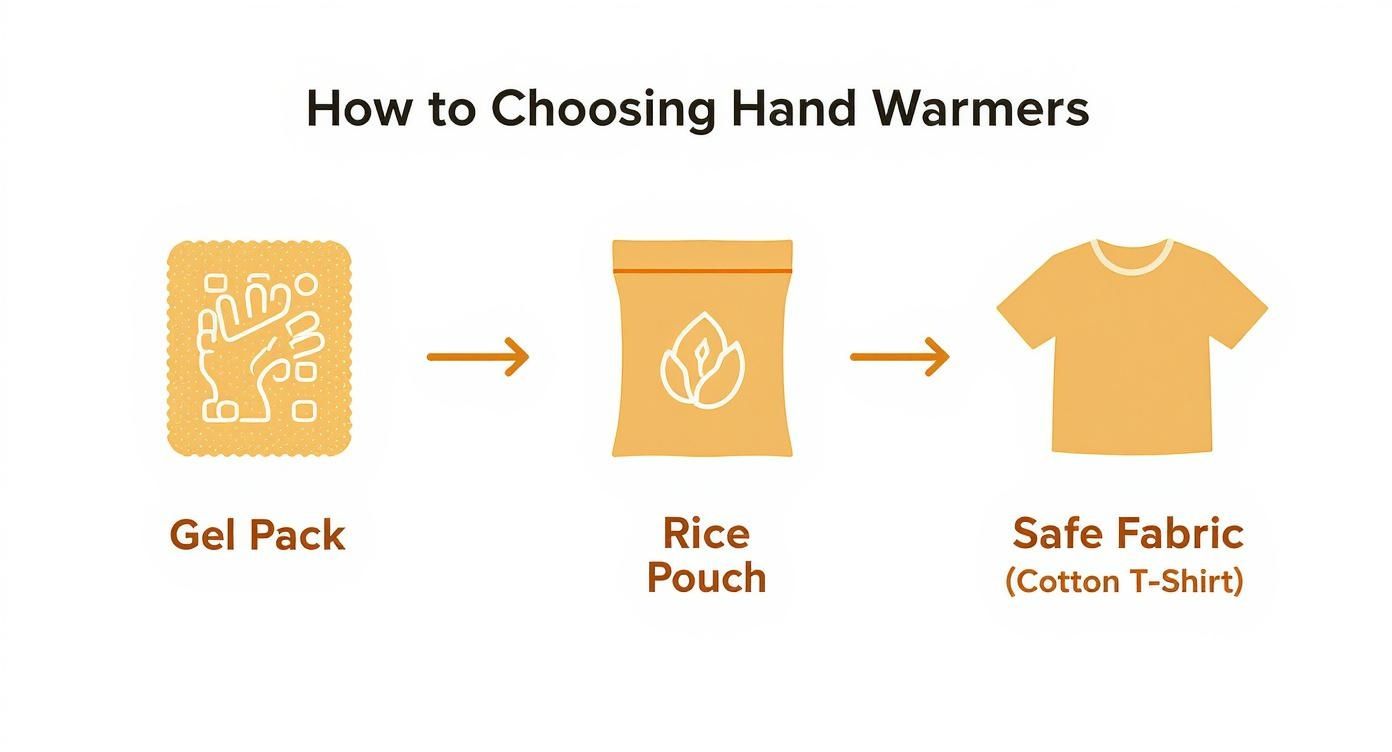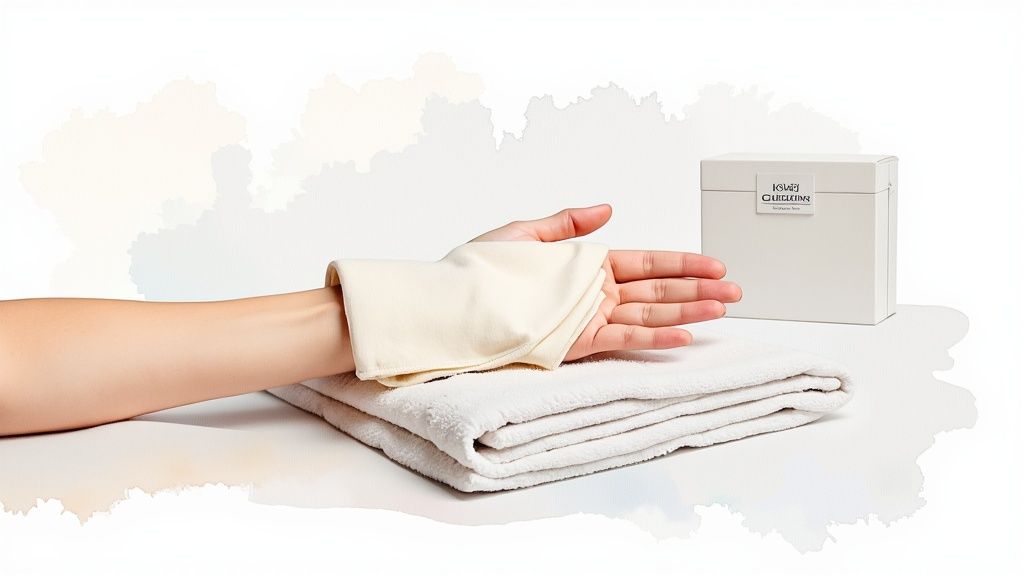Using a Hand Warmer in Microwave Safely
-
Using a hand warmer in the microwave is one of the quickest and easiest ways to get some portable, soothing heat. These little pouches, usually filled with things like rice or flaxseed, soak up energy from the microwave and then release it as a gentle warmth that's perfect for cold days or even easing sore joints.
Your Quick Guide to Microwave Hand Warmers
Forget about shivering on your way to work or trying to soothe stiff, aching hands after a long day at the keyboard. The humble microwavable hand warmer is a surprisingly effective little tool for instant comfort. And unlike those single-use chemical warmers, these reusable pouches are a much more sustainable way to stay cozy.
The science is simple. The fillings inside—rice, flaxseed, corn, or special gels—absorb and hold onto heat when you pop them in the microwave. That stored energy is then released slowly, giving you a consistent, gentle warmth that feels incredible, whether it's tucked into a pocket or just held in your hands.
To give you a quick overview, here's what you need to know before you get started.
Microwave Hand Warmer At a Glance
| Key Aspect | Common Fillings | Safe Fabrics | Average Heating Time | Typical Warmth Duration |
|---|---|---|---|---|
| The Basics | Rice, flaxseed, corn, cherry pits, or specialized gel beads. | 100% cotton or flannel are the go-to choices to prevent melting or fire hazards. | 20-45 seconds, depending on microwave wattage and warmer size. | 20 to 60 minutes, based on filling and insulation. |
This table should give you a solid foundation for understanding how these simple items work and what to expect.
More Than Just Warmth
But these aren't just for beating the cold. They're also a fantastic, simple tool for heat therapy. We've known for ages that applying localized heat helps increase blood flow, which in turn can relax tense muscles and soothe the discomfort from things like arthritis. Think of it as a mini, portable hot pack you can hold right where you need it. A warmed pouch can feel amazing on a stiff neck or even help relieve abdominal cramps.
Here's a great example of what a simple, fabric-based hand warmer looks like.

The cozy, pocket-sized design is what makes them so practical for everyday use, bridging the gap between convenience and therapeutic relief.
The real magic of these hand warmers is their dual function. One moment they're a practical tool against the cold, and the next they're a therapeutic aid for aches and pains.
Reusable hand warmers have really taken off because they're so convenient and eco-friendly. Depending on what's inside and how well they're insulated, you can expect them to stay warm for anywhere from 20 to 60 minutes. Safety is key, though—always make sure they're made from microwave-safe fabrics like cotton or flannel to avoid any risk of melting or fire. If you're crafty, you can even learn more about making your own reusable warmers.
Choosing the Right Microwavable Hand Warmer
Picking the right microwavable hand warmer is the single most important step for getting that cozy warmth safely. Not all of them are built the same, and your choice impacts everything from how long it stays warm to whether it’s even safe to use. You'll see all kinds out there, from commercial gel packs to simple homemade rice pouches.
What really matters are the two key components: the filling and the fabric. Different fillings have their own quirks. For instance, flaxseed is known to hold a moist heat longer than rice, which can feel incredibly soothing for achy joints. It's a small detail, but it can make a big difference if you're using it for therapeutic relief.

Safe Fabrics and Fillings Are Non-Negotiable
When it comes to the outer pouch, the material is a complete deal-breaker. You absolutely have to make sure the fabric is 100% cotton, wool, or flannel. Synthetic fabrics like polyester or rayon are a massive fire hazard—they can literally melt or catch fire in the microwave.
Just picture it: you toss a hand warmer made from polyester fleece into the microwave. In just a minute, you might smell burning plastic or find the fabric has fused together, ruining the warmer and maybe even your microwave. It's just not worth the risk.
The rule is simple: if the fabric isn't a natural fiber, don't put it in the microwave. The risk of fire or releasing harmful fumes is just too high to ignore.
This is why getting the materials right is so critical. You even have to check that the sewing thread is 100% cotton. When you're looking for comfort, especially for people with sensitive skin like seniors, making an informed choice is everything. You can find more practical advice in our guide to the best microwavable hand warmers for seniors. By sticking to natural, high-quality materials, you guarantee your experience will be both cozy and completely safe.
How to Heat Your Hand Warmer Without Mistakes
Getting your hand warmer perfectly heated is simple, but there's a right way and a wrong way to do it. The goal is to get that deep, soothing warmth that lasts, not a dangerously hot pouch that could cause a burn. A little bit of care goes a long way.
First, remember that not all microwaves are created equal. The power, measured in wattage, makes a huge difference. A beefy 1200-watt microwave heats things up in a flash compared to a compact 700-watt model. Because of this, you should always start low and go slow.
Finding the Sweet Spot for Warmth
Place your hand warmer on a clean microwave plate. The most critical step is to start with just 30 seconds. That’s it.
Once that first round is done, carefully take it out and check the temperature against the inside of your wrist. It's a sensitive spot and will give you a good read. If it's not quite warm enough, pop it back in for another 10 seconds at a time. Keep repeating this until it feels just right.
This gradual approach is your best defense against overheating, which can ruin the filling and, more importantly, burn your skin.

As you can see, choosing a warmer made with the right stuff—like 100% cotton and a safe filling like rice or flaxseed—is half the battle.
Essential Tips for Safe Heating
After years of using these, I've picked up a few tricks that make a real difference. Here are the ones I swear by:
- Add a Cup of Water: This is my favorite tip. Tossing a small, microwave-safe cup of water in there with the warmer adds a bit of moisture to the air. This simple trick helps prevent the filling from drying out or scorching.
- Let It Spin: Make sure the warmer can rotate freely on the turntable. If it gets jammed in a corner, one side will get blasted with heat, creating a nasty hot spot that could be a fire risk.
- Don't Walk Away: Seriously, stay by the microwave. It only takes a moment for things to go from perfectly warm to a burnt, smelly mess.
Overheating is the #1 mistake people make, but it's also the easiest one to avoid. When in doubt, start with less time. You can always add 10 more seconds, but you can't undo a burn.
Consumer safety reports often flag burn risks from microwaved items when people don't follow the instructions. For more information on different types of heat packs, our guide on microwavable hot packs has you covered. Following these simple precautions ensures you get all the cozy benefits without any of the risks.
More Than Just Warmth: Unlocking Heat and Massage Benefits
A heated hand warmer is so much more than just a cozy little pouch; it's a surprisingly effective wellness tool you can use every day. The power of heat therapy isn't just a feeling; it's a science-backed method for wellness. Applying localized heat works by boosting blood flow to a specific area, which helps tight muscles relax and can significantly soothe aches from conditions like arthritis or general stiffness.
https://www.youtube.com/embed/3eC7nB5cxzQ
Imagine coming home after a long day hunched over a computer, a familiar ache settling into your neck. Instead of reaching for a painkiller, picture yourself gently draping a warm pouch over your shoulders. Within minutes, the targeted warmth begins to melt the tension away. This simple, natural approach can also work wonders for easing abdominal cramps or loosening up a stiff lower back, giving you comfort exactly where you need it. To explore the science further, check out our guide on understanding the basics of heat therapy.
Take It to the Next Level with Gentle Massage
Ready for a pro tip? You can easily amplify the relief by adding a bit of gentle massage into the mix. This simple addition turns your hand warmer in microwave from just a heat source into an active therapeutic tool. The warmth gets the muscles ready for massage, making them softer and more receptive.
For example, if you struggle with arthritis in your hands, the combination of heat and gentle massage can be a game-changer. Use the warm, soft pouch to gently knead aching knuckles and massage the muscles around your wrists. This dual action boosts circulation and flexibility, providing a much deeper sense of relief than warmth alone ever could.
- Stiff Fingers? Gently roll the warm pouch over your fingers and knuckles to ease joint pain.
- Sore Neck? Rest the warmer on your shoulder and use your hand to apply light, circular pressure to release knots.
- Tense Shoulders? Just drape it over your shoulder and let the weighted warmth work its magic, relieving the day's stress.
It's a simple, incredibly effective way to unwind and feel better.
The real secret is consistency. A few minutes of combined heat and massage each day can make a world of difference in managing chronic discomfort and promoting relaxation.
The best part is how accessible this is. Microwave ovens have become a kitchen staple since they first hit the market. In fact, by 2020, over 90% of homes in developed countries had one. This makes it incredibly easy for just about anyone to get fast, therapeutic relief right at home. You can learn more about the science and safety behind them on the FDA's page about microwave ovens.
Keeping Your Hand Warmer Safe and Clean
Think of your microwavable hand warmer as a trusted friend on a cold day. With a little bit of care, you can keep it in great shape for years to come. It’s not complicated, but proper maintenance is key to making sure it’s always safe and ready when you need it.

For most little spills or smudges, a quick spot clean is all it takes. Just grab a damp cloth, maybe a touch of mild soap, and gently wipe the area. Easy.
If your warmer has a removable cover—a feature I always recommend looking for—you can usually toss it in the washing machine on a gentle cycle. Just be absolutely sure it air dries completely before you put it back on and use it again.
Proper Storage and Knowing When to Say Goodbye
Where you keep your hand warmer when you're not using it actually matters quite a bit. Tuck it away in a cool, dry place, like a drawer or a breathable cotton bag. This simple step helps prevent the natural filling from getting musty or attracting unwanted pests.
But even the most well-cared-for hand warmer won't last forever. Being able to spot the signs of wear and tear is crucial for your safety.
It’s time for a replacement if you notice any of these red flags:
- A Funky, Scorched Smell: If you catch a persistent burnt odor after heating it, that’s a sure sign the filling inside has been compromised.
- Worn-Out Fabric: Can you see the fabric thinning in certain spots? Those weak points could easily become a tear, spilling hot filling everywhere.
- Obvious Damage: This one’s a no-brainer. Any visible holes, tears, or scorch marks mean it's officially retired.
Paying attention to these small details isn't just about making your hand warmer last longer. It's about putting your safety first so that every time you use it, you get nothing but pure, cozy comfort.
Frequently Asked Questions About Microwavable Hand Warmers
Even after you've got the basics down, you might still have a few questions about your microwavable hand warmer. That's completely normal. Let's tackle some of the most common ones so you can use your warmer confidently and safely.
The number one question I hear is about heating time. How long is really long enough? My best advice is to always start with 30 seconds. From there, you can add time in short 10-second bursts until it's just right. Every microwave heats differently, so this careful approach is your best bet to avoid overheating.

Heating, Safety, and More
Can I make my own?
Absolutely, but you have to be very careful with materials. Stick to 100% natural fibers like cotton or flannel for the pouch and use only cotton thread. Synthetics like polyester can melt or even catch fire in the microwave, which is a serious hazard.
What does that burnt smell mean?
If you notice a scorched smell, stop using the warmer immediately. This is a tell-tale sign that the filling (like rice or flaxseed) has been overheated and burnt. At this point, the warmer is a fire risk and needs to be thrown away. Don't take a chance.
Is it safe to sleep with my hand warmer?
It might be tempting to fall asleep with a cozy warmer, but please don't. Even as it cools, the prolonged contact against your skin can lead to mild burns. A great alternative is to use it to pre-warm your bed, then set it aside before you drift off.
Think of your hand warmer as a simple tool for comfort. When you follow these safety ground rules, you can make sure every use is a safe and soothing one.
Here’s a tip: try combining the gentle heat with a light massage. Gently kneading stiff, arthritic fingers with the warm pouch can do wonders for circulation and ease that nagging ache without reaching for a pill bottle.
For over 20 years, SunnyBay has been a trusted name for simple, effective, U.S.-made heat therapy solutions in homes and clinics alike. Find drug-free pain relief and everyday comfort by exploring our products at https://sunny-bay.com.
Article created using Outrank




